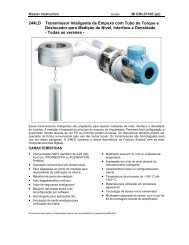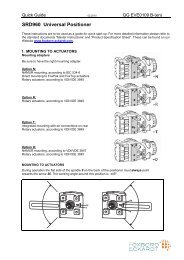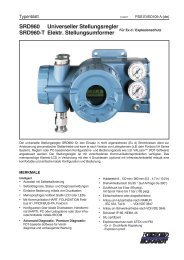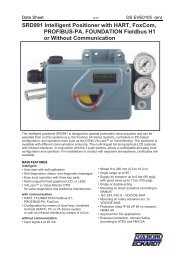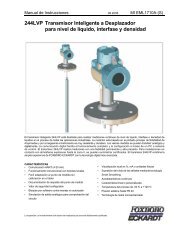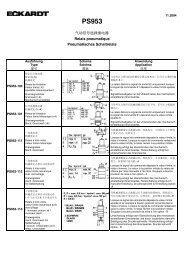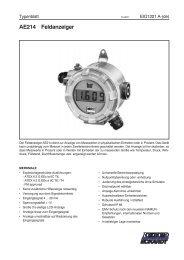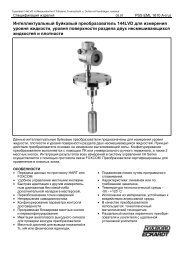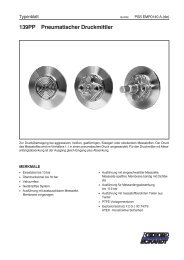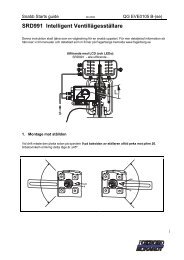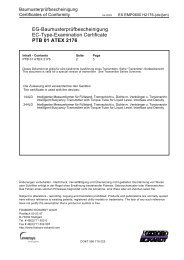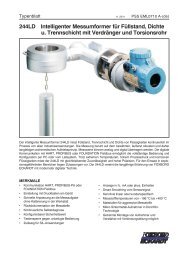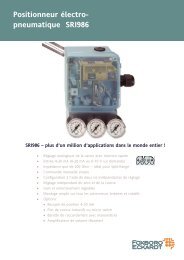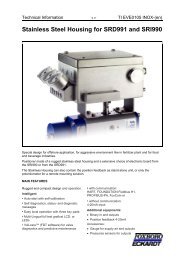SRI983 Electro-Pneumatic Positioner - explosion ... - Foxboro Eckardt
SRI983 Electro-Pneumatic Positioner - explosion ... - Foxboro Eckardt
SRI983 Electro-Pneumatic Positioner - explosion ... - Foxboro Eckardt
You also want an ePaper? Increase the reach of your titles
YUMPU automatically turns print PDFs into web optimized ePapers that Google loves.
14 <strong>SRI983</strong> MI EVE0103 A-(en)<br />
4.5 Determination of rotation angle factor Uϕ<br />
In conjunction with the attachment kit for rotary actuators<br />
(Code EBZG-PN, -MN, -JN, -ZN, -RN) the rotation angle<br />
factor Uϕ can be determined as follows:<br />
ϕ<br />
Rotation angle<br />
Uϕ =<br />
=<br />
∆ w Input signal range [ mA ]<br />
The rotation angle factors Uϕ of the individual range springs<br />
are stated in the following table.<br />
The rotation angles are also taken into account in the graph<br />
of the range springs (see page 15).<br />
4.6 Determination of stroke factor UX The stroke factor Ux is the ratio of the entire range of the<br />
output variable (stroke x) to the entire range of the input<br />
variable (command variable w).<br />
For FOXBORO ECKARDT diaphragm actuators PA-200 to<br />
PA700/702 :<br />
x<br />
Stroke in mm<br />
Ux =<br />
=<br />
∆ w Input signal range in mA<br />
Range spring Cam 1)<br />
Ident No. old ID Colour<br />
1 420 493 013 FES 627/1 yellow<br />
2 420 494 019 FES 628/1 green<br />
3 502 558 017 FES 612/1 - without -<br />
4 420 496 011 FES 715/1 gray<br />
5 420 495 014 FES 629/1 blue<br />
linear<br />
For FOXBORO ECKARDT diaphragm actuators 1500 cm²<br />
and actuators of other manufacturers (Io = 117.5 mm 1) ):<br />
Ux =<br />
x<br />
Io<br />
×<br />
∆ w Is<br />
Is = Feedback lever length in mm (for FOXBORO<br />
ECKARDT actuator 1500 cm²: Is = 122.5 mm)<br />
The stroke factor can be used to determine for each application<br />
whether or with which spring the desired setting can<br />
be made.<br />
Five different range springs are available for matching to<br />
the stroke and input signal range.<br />
4.6.1 Stroke factor ranges of the range springs<br />
ThestrokefactorUx determined as described above should<br />
lie within the ranges of the respective range springs indicated<br />
in the following table, as close as possible to the lower<br />
value.<br />
Equal perc. and<br />
inverse<br />
equal perc.<br />
max. 120° max. 90°<br />
1.7 ... 4.7<br />
(max. 7)<br />
3.5 ... 9.5<br />
(max. 14)<br />
5.8 ... 14.5<br />
(max. 21.75)<br />
8.4 ... 21.5<br />
(max. 32.75)<br />
11.5 ... 27.5<br />
(max. 41.5)<br />
2.4 ... 8<br />
(max. 10)<br />
5 ... 15<br />
(max. 20)<br />
8.2 ... 24<br />
(max. 28)<br />
12 ... 35<br />
(max. 43)<br />
-<br />
Stroke factor ranges<br />
Stroke factor<br />
Ux<br />
mm<br />
mA<br />
0.4 ... 1.2<br />
(max. 1,7)<br />
0.85 ... 2.3<br />
(max. 3.35)<br />
1.4 ... 3.5<br />
(max. 5.25)<br />
2.0 ... 5.5<br />
(max. 7.9)<br />
2.75 ... 7.0<br />
(max. 10)<br />
Stroke<br />
range 2)<br />
mm<br />
Remarks<br />
8 ... 34 2)<br />
17 ... 68 built-in<br />
28 ... 105 2)<br />
40 ... 158 3)<br />
55 ... 200 3)<br />
1) For equal percentage and inverse equal percentage cams the rotation angle factors are a function of their corresponding rotation angles.<br />
2) Included in FESG-FN (Id No. 420 496 011)<br />
2)<br />
2)



